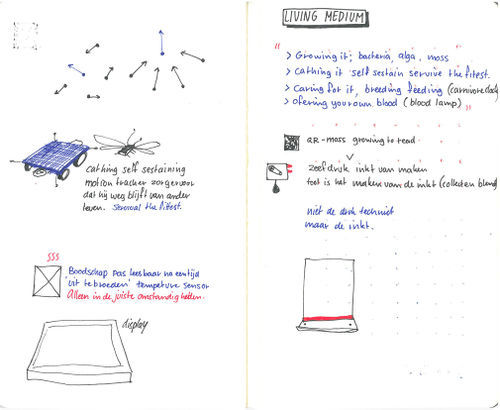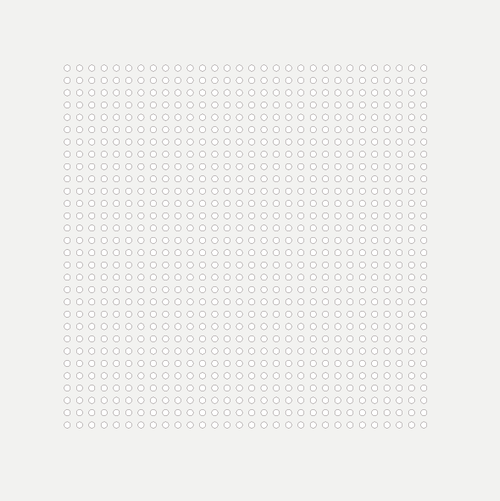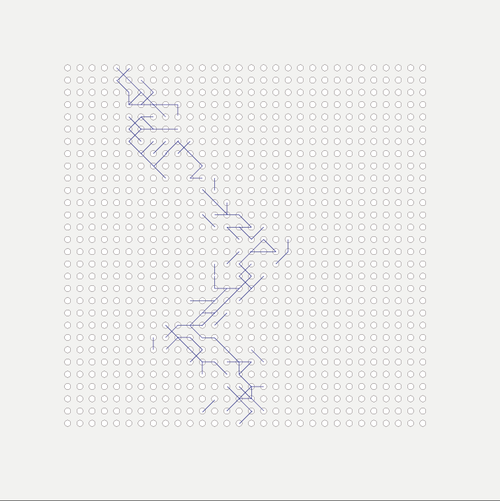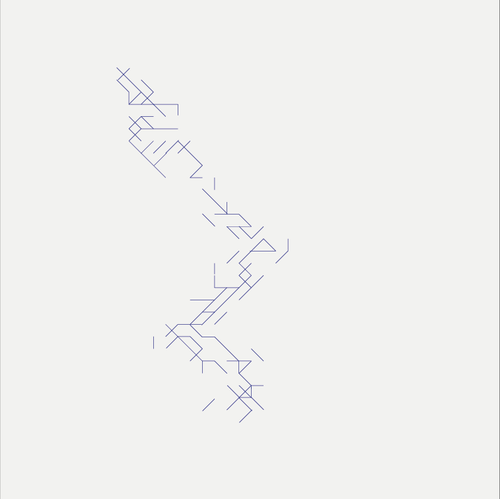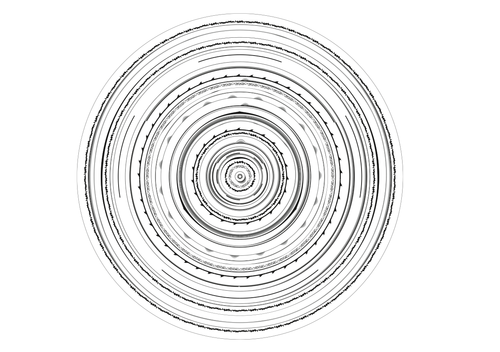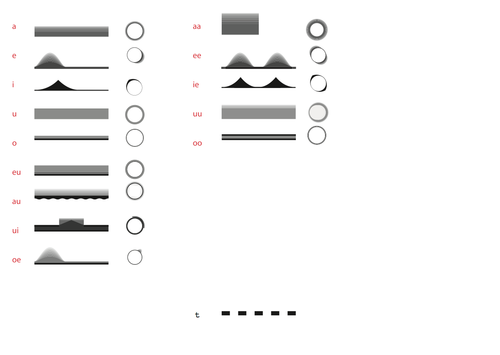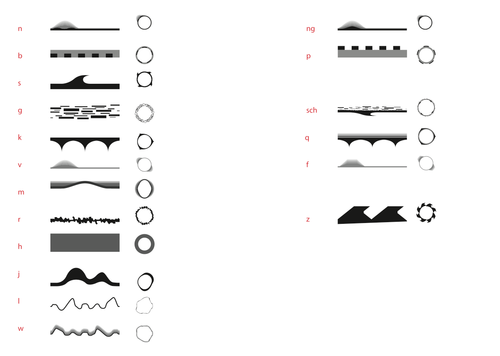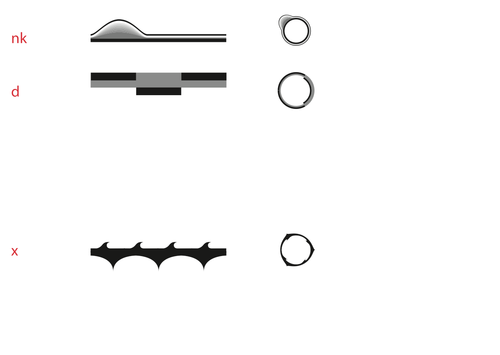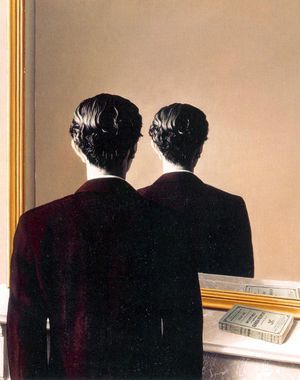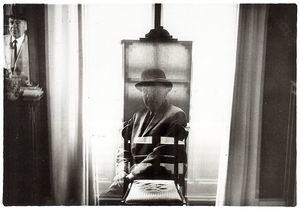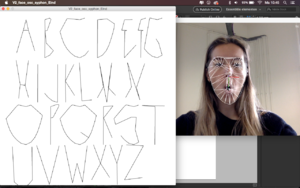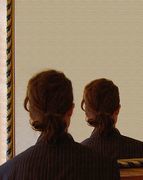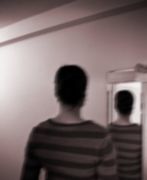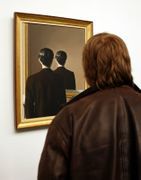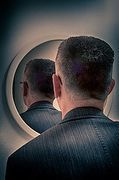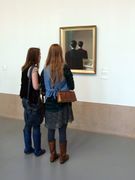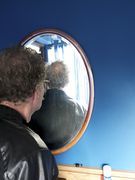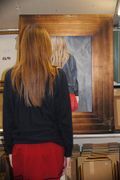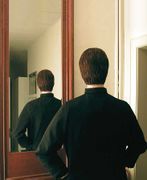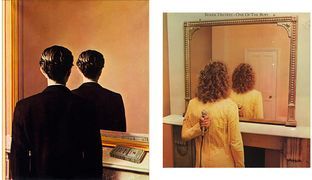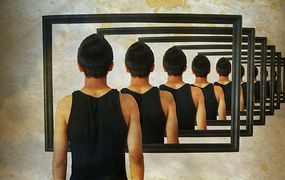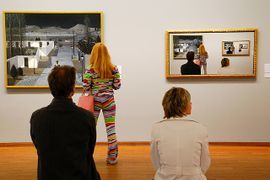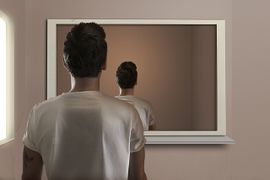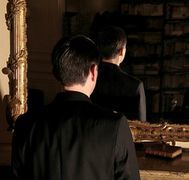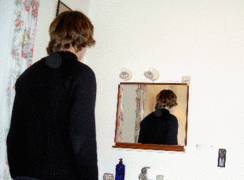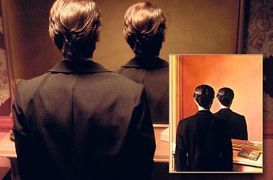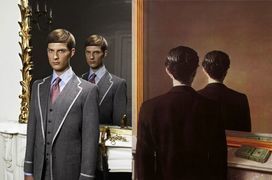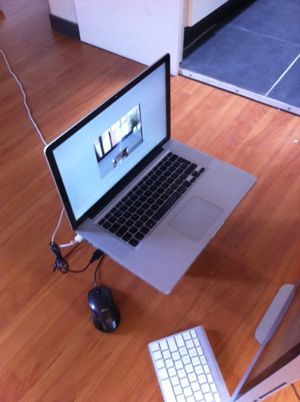Difference between revisions of "User:B.Smulders"
B.Smulders (talk | contribs) (→Ideas) |
B.Smulders (talk | contribs) |
||
| (11 intermediate revisions by the same user not shown) | |||
| Line 35: | Line 35: | ||
[http://www.lossless.net/projects/asynchrony/ Lossless] <br><br> | [http://www.lossless.net/projects/asynchrony/ Lossless] <br><br> | ||
<u>QUARTER 2</u><br> | <u>QUARTER 2</u><br> | ||
| + | [http://www.materialbeliefs.com/prototypes/cder.php Carnivorous Domestic Entertainment Robots] <br> | ||
| + | [http://thoughtcollider.nl/project/blood-lamp Blood Lamp] <br> | ||
| + | [http://www.wikihow.com/Make-Moss-Graffiti Moss Grafitti]<br> | ||
| + | Scans from the book Bio Design.<br> | ||
| + | [[File:SCAN 06.jpg|140px]] | ||
| + | [[File:SCAN 07.jpg|140px]] | ||
| + | [[File:SCAN 10.jpg|140px]] | ||
| + | [[File:SCAN 09.jpg|140px]] | ||
| + | [[File:SCAN 08.jpg|140px]]<br> | ||
| + | [[File:SCAN 01.jpg|140px]] | ||
| + | [[File:SCAN 02.jpg|140px]] | ||
| + | [[File:SCAN 03.jpg|140px]] | ||
| + | [[File:SCAN 04.jpg|140px]] | ||
| + | [[File:SCAN 05.jpg|140px]]<br> | ||
</span> | </span> | ||
| Line 46: | Line 60: | ||
==Ideas== | ==Ideas== | ||
===Living Medium=== | ===Living Medium=== | ||
| + | [[File:SKMBT C36014112709451.jpg|500px]] | ||
===Movement Communication Tool=== | ===Movement Communication Tool=== | ||
| + | [[File:SKMBT C36014112709450.jpg|500px]]<br> | ||
| + | [[File:Schermafbeelding iMac 2014-11-27 om 10.46.39.png|500px]] | ||
| + | [[File:Schermafbeelding iMac 2014-11-27 om 10.39.09.png|500px]] | ||
| + | [[File:Schermafbeelding iMac 2014-11-27 om 10.39.23.png|500px]] | ||
===Visual Phoneme=== | ===Visual Phoneme=== | ||
| + | [[File:Schermafbeelding iMac 2014-11-27 om 10.35.53.png|500px]] | ||
| + | [[File:Schermafbeelding iMac 2014-11-27 om 10.36.04.png|500px]]<br> | ||
| + | [[File:Schermafbeelding iMac 2014-11-27 om 10.36.15.png|500px]] | ||
| + | [[File:Schermafbeelding iMac 2014-11-27 om 10.36.19.png|500px]] | ||
| + | [[File:Schermafbeelding iMac 2014-11-27 om 10.36.23.png|500px]] | ||
==Demo== | ==Demo== | ||
| + | <source lang="java"> | ||
| + | import processing.video.*; | ||
| + | Capture video; | ||
| + | PImage prevFrame; | ||
| + | int threshold = 50; | ||
| + | |||
| + | void setup() { | ||
| + | size(960, 720); | ||
| + | video = new Capture(this, width, height, 30); | ||
| + | prevFrame = createImage(video.width,video.height,RGB); | ||
| + | video.start(); | ||
| + | } | ||
| + | |||
| + | void draw() { | ||
| + | if (video.available()) { | ||
| + | prevFrame.copy(video,0,0,video.width,video.height,0,0,video.width,video.height); // De vorige frame bewaren | ||
| + | prevFrame.updatePixels(); | ||
| + | video.read(); | ||
| + | } | ||
| + | |||
| + | loadPixels(); | ||
| + | video.loadPixels(); | ||
| + | prevFrame.loadPixels(); | ||
| + | |||
| + | // Begin loop die elke pixel afloopt | ||
| + | for (int x = 0; x < video.width; x ++ ) { | ||
| + | for (int y = 0; y < video.height; y ++ ) { | ||
| + | |||
| + | int loc = x + y*video.width; | ||
| + | color current = video.pixels[loc]; | ||
| + | color previous = prevFrame.pixels[loc]; | ||
| + | |||
| + | float r1 = red(current); float g1 = green(current); float b1 = blue(current); | ||
| + | float r2 = red(previous); float g2 = green(previous); float b2 = blue(previous); | ||
| + | float diff = dist(r1,g1,b1,r2,g2,b2); | ||
| + | |||
| + | if (diff > threshold) { | ||
| + | |||
| + | pixels[loc] = color(0); | ||
| + | } else { | ||
| + | pixels[loc] = color(255); | ||
| + | } | ||
| + | } | ||
| + | } | ||
| + | updatePixels(); | ||
| + | } | ||
| + | </source> | ||
| + | <br><br> | ||
| + | |||
| + | ==Living Medium== | ||
| + | |||
| + | |||
| + | |||
| + | |||
| + | |||
| + | |||
| + | |||
| + | |||
| + | |||
| + | |||
| + | |||
| + | |||
| + | |||
| + | |||
| + | |||
| + | |||
| + | |||
| + | |||
<span style='width:100%; font-size:20px; font-family:Arial; display:block; padding:20px; color:2c2c2c; background:#ffd9b4; border-bottom: solid; border-bottom-color: black; border-width: 1px; text-transform: uppercase;'> | <span style='width:100%; font-size:20px; font-family:Arial; display:block; padding:20px; color:2c2c2c; background:#ffd9b4; border-bottom: solid; border-bottom-color: black; border-width: 1px; text-transform: uppercase;'> | ||
Latest revision as of 12:00, 15 December 2014
ABOUT
Bor Smulders
Graphic Design
Portofolio
Documents First meeting a stereoscopic viewer
Inspiration
QUARTER 1
The Crowbox Kit
Streat ereasermerging the digital world with the analog
Real World Third Person Perspective VR / AR Experiment
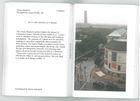 Scan from the book: Designs of the year 2014. Designed by James Bridle
Scan from the book: Designs of the year 2014. Designed by James Bridle
Pilvi Takala Real snow white
Delay Canvas
Magyar
David Hockney
Lossless
QUARTER 2
Carnivorous Domestic Entertainment Robots
Blood Lamp
Moss Grafitti
Scans from the book Bio Design.










Tools of the Trade
Contents
Theme
Visually transferring data in a critical way to the viewer is my craft. As Graphic Designer I consider media as a tool, a tool that gives visual output. And creates a change in the viewers look on reality or the content. I want to create my own medium for certain data or messages. This will make the media more part of the design process.
Ideas
Living Medium
Movement Communication Tool
Visual Phoneme
Demo
import processing.video.*;
Capture video;
PImage prevFrame;
int threshold = 50;
void setup() {
size(960, 720);
video = new Capture(this, width, height, 30);
prevFrame = createImage(video.width,video.height,RGB);
video.start();
}
void draw() {
if (video.available()) {
prevFrame.copy(video,0,0,video.width,video.height,0,0,video.width,video.height); // De vorige frame bewaren
prevFrame.updatePixels();
video.read();
}
loadPixels();
video.loadPixels();
prevFrame.loadPixels();
// Begin loop die elke pixel afloopt
for (int x = 0; x < video.width; x ++ ) {
for (int y = 0; y < video.height; y ++ ) {
int loc = x + y*video.width;
color current = video.pixels[loc];
color previous = prevFrame.pixels[loc];
float r1 = red(current); float g1 = green(current); float b1 = blue(current);
float r2 = red(previous); float g2 = green(previous); float b2 = blue(previous);
float diff = dist(r1,g1,b1,r2,g2,b2);
if (diff > threshold) {
pixels[loc] = color(0);
} else {
pixels[loc] = color(255);
}
}
}
updatePixels();
}
Living Medium
Boijmans Object
Object
La reproduction interdite
Not to be Reproduced
by René Magritte - 1937
The thing that interested the Belgian surrealist artist Magritte was the mystery that lay in everyday visible reality. He was not so much inspired by the invisible, the subconscious and dream images but rather by ordinary objects to which he gave a twist. The man Magritte portrays here is the eccentric wealthy Englishman Edward James. He was a friend of the artist and bought various works from him. In the 1930s Edward James was the benefactor of both Dalí and Magritte. Magritte based the portrait on a photograph he made of Edward James looking at the painting 'On the threshold of freedom'.
Title: La reproduction interdite
Painter: René Magritte, Lessen 1898 - Brussel 1967
Year: 1937
Type of object: painting
Dimensions: 81,5 x 65,5 x 2 cm
Material and technique: oil on canvas
Source: Boijmans
René Magritte
Rene Magritte by Duane Stephen Michals - 1965
Belgian Surrealist painter. Born at Lessines. Studied at the Académie des Beaux-Arts in Brussels 1916-18, and settled in Brussels. Made his living for a time by designing wallpaper and drawing fashion advertisements. Became very friendly with poets and writers such as Mesens, Goemans, Scutenaire and Nougé, who shared his interest in evoking mystery and were later the founders of the Belgian Surrealist group. Turned away from his early Cubist-Futurist experiments in 1925 under the influence of de Chirico; began to explore ways of creating a poetic, disturbing effect by depicting recognisable objects in alien settings, by startling juxtapositions or combinations of objects, by inversions of scale and so on. First one-man exhibition at the Galerie Le Centaure, Brussels, 1927. Afterwards lived from 1927-30 at Perreux-sur-Marne, a suburb of Paris, where he met Miró, Arp, Tanguy, Dali, Buñuel, Eluard and Breton. In 1930 returned to Brussels, where he spent the rest of his life. A cycle of murals, 'The Enchanted Domain', was painted from his designs in the Casino at Knokke in 1951-3, and eight sculptures were made under his supervision in 1967 from themes in his paintings. Died in Brussels.
Source: Tate Modern - http://www.tate.org.uk/art/artists/rene-magritte-1553
Magritte's work frequently displays a collection of ordinary objects in an unusual context, giving new meanings to familiar things. The use of objects as other than what they seem is typified in his painting, 'The Treachery of Images' (La trahison des images), which shows a pipe that looks as though it is a model for a tobacco store advertisement. Magritte painted below the pipe "Ceci n'est pas une pipe" ("This is not a pipe"), which seems a contradiction, but is actually true: the painting is not a pipe, it is an image of a pipe. It does not "satisfy emotionally"—when Magritte was once asked about this image, he replied that of course it was not a pipe, just try to fill it with tobacco.
Magritte used the same approach in a painting of an apple: he painted the fruit and then used an internal caption or framing device to deny that the item was an apple. In these "Ceci n'est pas" works, Magritte points out that no matter how naturalistically we depict an object, we never do catch the item itself.
Among Magritte's works are a number of surrealist versions of other famous paintings. Elsewhere, Magritte challenges the difficulty of artwork to convey meaning with a recurring motif of an easel, as in his The Human Condition series (1933, 1935) or The Promenades of Euclid (1955) (wherein the spires of a castle are "painted" upon the ordinary streets which the canvas overlooks). In a letter to André Breton, he wrote of The Human Condition that it was irrelevant if the scene behind the easel differed from what was depicted upon it, "but the main thing was to eliminate the difference between a view seen from outside and from inside a room." The windows in some of these pictures are framed with heavy drapes, suggesting a theatrical motif.
Magritte's style of surrealism is more representational than the "automatic" style of artists such as Joan Miró. Magritte's use of ordinary objects in unfamiliar spaces is joined to his desire to create poetic imagery. He described the act of painting as "the art of putting colors side by side in such a way that their real aspect is effaced, so that familiar objects—the sky, people, trees, mountains, furniture, the stars, solid structures, graffiti—become united in a single poetically disciplined image. The poetry of this image dispenses with any symbolic significance, old or new."
René Magritte described his paintings as "visible images which conceal nothing; they evoke mystery and, indeed, when one sees one of my pictures, one asks oneself this simple question, 'What does that mean?'. It does not mean anything, because mystery means nothing either, it is unknowable."
Magritte's constant play with reality and illusion has been attributed to the early death of his mother. Psychoanalysts who have examined bereaved children have hypothesized that Magritte's back and forth play with reality and illusion reflects his "constant shifting back and forth from what he wishes—'mother is alive'—to what he knows—'mother is dead'
Contemporary artists have been greatly influenced by René Magritte's stimulating examination of the fickleness of images. Some artists who have been influenced by Magritte's works include John Baldessari, Ed Ruscha, Andy Warhol, Jasper Johns, Jan Verdoodt, Martin Kippenberger, Duane Michals and Storm Thorgerson. Some of the artists' works integrate direct references and others offer contemporary viewpoints on his abstract fixations.
Magritte's use of simple graphic and everyday imagery has been compared to that of the Pop artists. His influence in the development of Pop art has been widely recognized,[21] although Magritte himself discounted the connection. He considered the Pop artists' representation of "the world as it is" as "their error", and contrasted their attention to the transitory with his concern for "the feeling for the real, insofar as it is permanent." The 2006–2007 LACMA exhibition "Magritte and Contemporary Art: The Treachery of Images" examined the relationship between Magritte and contemporary art.
Source: Wikipedia - http://en.wikipedia.org/wiki/René_Magritte
Surrealism
Surrealism originated in the late 1910s and early '20s as a literary movement that experimented with a new mode of expression called automatic writing, or automatism, which sought to release the unbridled imagination of the subconscious. Officially consecrated in Paris in 1924 with the publication of the Manifesto of Surrealism by the poet and critic André Breton (1896–1966), Surrealism became an international intellectual and political movement. Breton, a trained psychiatrist, along with French poets Louis Aragon (1897–1982), Paul Éluard (1895–1952), and Philippe Soupault (1897–1990), were influenced by the psychological theories and dream studies of Sigmund Freud (1856–1939) and the political ideas of Karl Marx (1818–1883). Using Freudian methods of free association, their poetry and prose drew upon the private world of the mind, traditionally restricted by reason and societal limitations, to produce surprising, unexpected imagery. The cerebral and irrational tenets of Surrealism find their ancestry in the clever and whimsical disregard for tradition fostered by Dadaism a decade earlier.
…
In 1927, the Belgian artist René Magritte (1898–1967) moved from Brussels to Paris and became a leading figure in the visual Surrealist movement. Influenced by de Chirico's paintings between 1910 and 1920, Magritte painted erotically explicit objects juxtaposed in dreamlike surroundings. His work defined a split between the visual automatism fostered by Masson and Miró (and originally with words by Breton) and a new form of illusionistic Surrealism practiced by the Spaniard Salvador Dalí (1904–1989), the Belgian Paul Delvaux (1897–1994), and the French-American Yves Tanguy (1900–1955). In The Eternally Obvious, Magritte's artistic display of a dismembered female nude is emotionally shocking. In The Satin Tuning Fork, Tanguy fills an illusionistic space with unidentifiable, yet sexually suggestive, objects rendered with great precision. The painting's mysterious lighting, long shadows, deep receding space, and sense of loneliness also recall the ominous settings of de Chirico.
In 1929, Dalí moved from Spain to Paris and made his first Surrealist paintings. He expanded on Magritte's dream imagery with his own erotically charged, hallucinatory visions. In The Accommodations of Desire of 1929, Dalí employs Freudian symbols, such as ants, to symbolize his overwhelming sexual desire. In 1930, Breton praised Dalí's representations of the unconscious in the Second Manifesto of Surrealism. They became the main collaborators on the review Minotaure (1933–39), a primarily Surrealist-oriented publication founded in Paris.
The organized Surrealist movement in Europe dissolved with the onset of World War II. Breton, Dalí, Ernst, Masson, and others, including the Chilean artist Matta (1911–2002), who first joined the Surrealists in 1937, left Europe for New York. The movement found renewal in the United States at Peggy Guggenheim's (1898–1979) gallery, Art of This Century, and the Julien Levy Gallery. In 1940, Breton organized the fourth International Surrealist Exhibition in Mexico City, which included the Mexicans Frida Kahlo (1907–1954) and Diego Rivera (1886–1957) (although neither artist officially joined the movement). Surrealism's surprising imagery, deep symbolism, refined painting techniques, and disdain for convention influenced later generations of artists, including Joseph Cornell (1903–1972) and Arshile Gorky (1904–1948), the latter whose work formed a continuum between Surrealism and Abstract Expressionism.
Source: the Metropolitan museum of art
Simulacrum
Baudrillards simulacrumtheorie gaat over de echtheid en werkelijkheid van beelden die wij denken te kennen. In deze theorie wordt gesteld dat de mens het contact met de echte wereld is verloren, doordat hij een beeld van de wereld creëert aan de hand van wat hij in de media ziet. Baudrillard zei dat er steeds minder waarheid is, omdat we al onze werkelijkheid baseren op iets wat we zelf (de mensheid) hebben bedacht (in film en media). Een voorbeeld van een 'simulacrum' is dat iedereen weet hoe een neerstortend vliegtuig eruit ziet. Maar wij weten dit doordat we dit op televisie hebben gezien. Het 'kennen' van dit beeld is dus niet gebaseerd op onze eigen waarheid, maar op de waarheid die gecreëerd is op tv. Zijn simulacrumtheorie plaatst de realiteit lijnrecht tegenover de door de beeldcultuur gecreëerde illusie van werkelijkheid (hyperrealiteit genoemd). Een simulacrum is een kopie zonder origineel, het is dus niet meer te linken aan iets origineels, iets echts.
Copies
The first 88 images of the painting on 'La reproduction interdite' in Google images search. which one is the original? None of the images I found had the same color contrast or size. I realy wonder if the are all copies of the same picture, or are they all a different photo of the painting? To me this is interesting because the 'real' one is in the storage of the Boijmans museum. So which one do I have to copy?
notable imitations
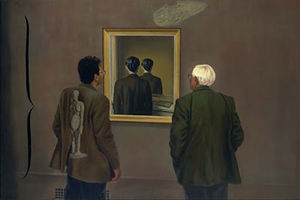
Three Painters by Atul Dodiya 1996
Atul Dodiya made this painting of two painter looking at a painting. I believe he tries t create an extra dimension to a Réne's work. there are also other references to surrealistic artworks. undortunate there is very little information about the painter and the painting.
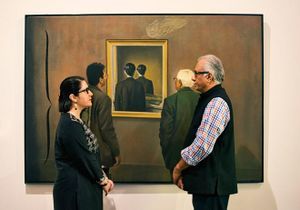
An extra extra layer to the painting. The painter of the painting and his wife
Source: http://indiatoday.intoday.in/story/atul-and-anju-dodiya-interview/1/330838.html
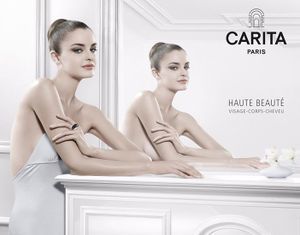
An add by Carita Paris
Highly inspired by La reproduction interdite. A lot of Réne Magritte's work is copied in commercial posters. By turning the face to the viewer to photo gives a different effect. Instead of anonymity and counter-dialogical it shows a confrontation to the viewer, dubble-dialogical. It shows what we want to see instead of showing us what we don't want to see.
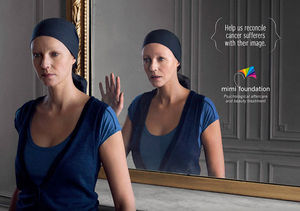
An add by the Mimi Foundation
Similar to the add from Carita Paris, although this add shows more of an denial. an confrontation we prefer to ignore. The part that differs the most between the adds is that the woman doesn't look you the viewer straight into the eyes. It feels more closed of then the original painting.
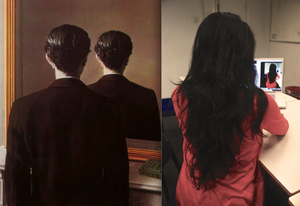
Rowenna Chanskey 2013
The most recent imitation of the painting I could find. The most interesting part about this one that it doesn't looks photoshopped. It's clearly a different but similar picture on the screen.
Perfect Copie
Experiments
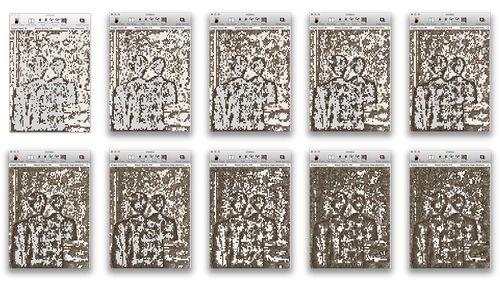
Trying to create a copy of the painting with... copies of the painting. With MacOsaiX
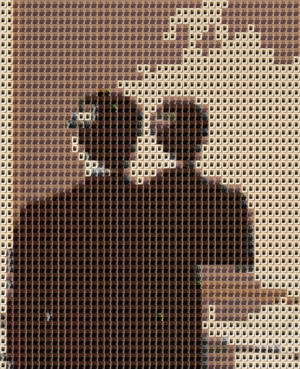
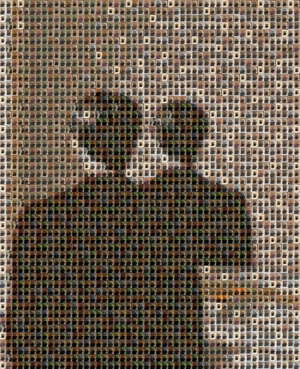
Succesvol attempts. The first is without any rules, and thus simpler.
The second is made with the rule that none of the images can be next to each other twice and at least 30 of the 80 images must be used.
The interesting part is that it uses the most red, blue and green one for the black parts; like RGB.
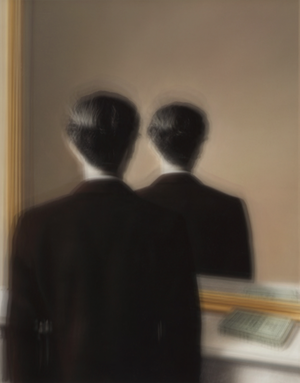
All copies merged into one. Layer over layer.
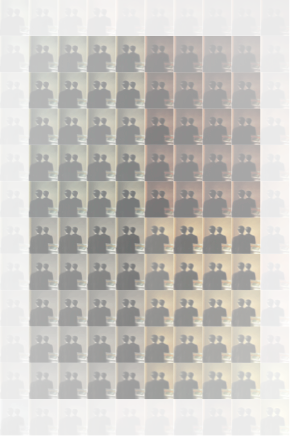
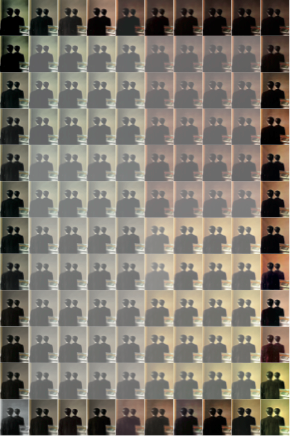
Tint or shades made out of the painting. The diversity is made more visible.
CMYK
The next images are all 40 copy split in the 4 process colors.
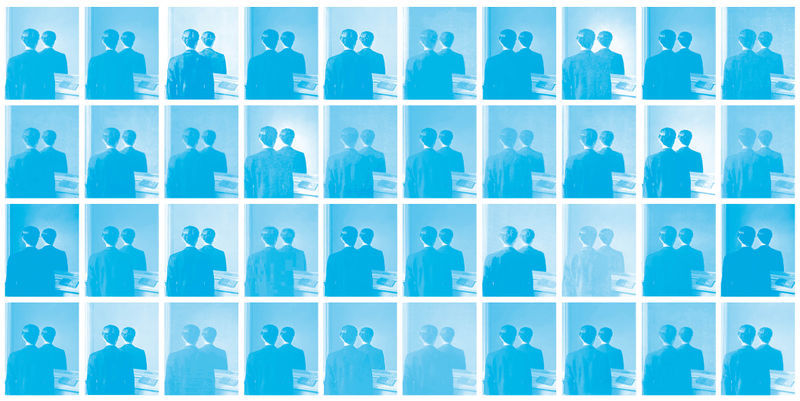
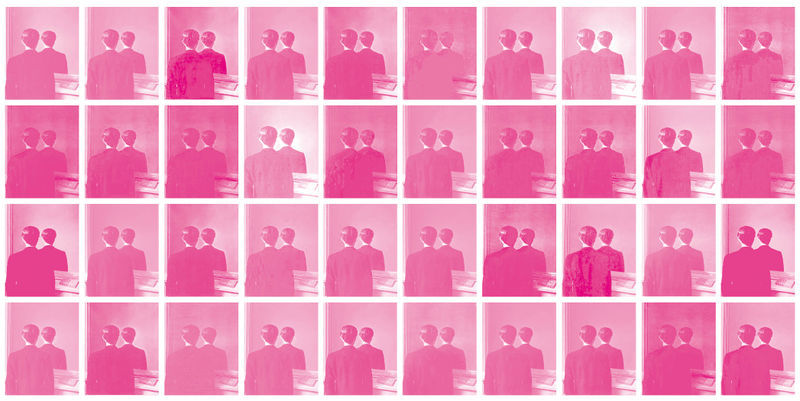
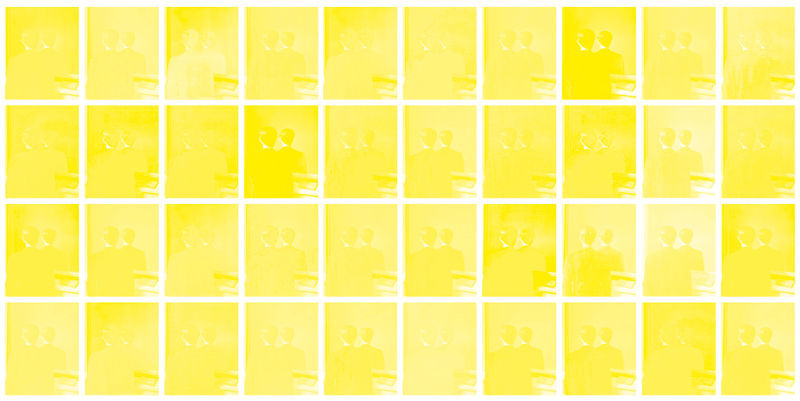

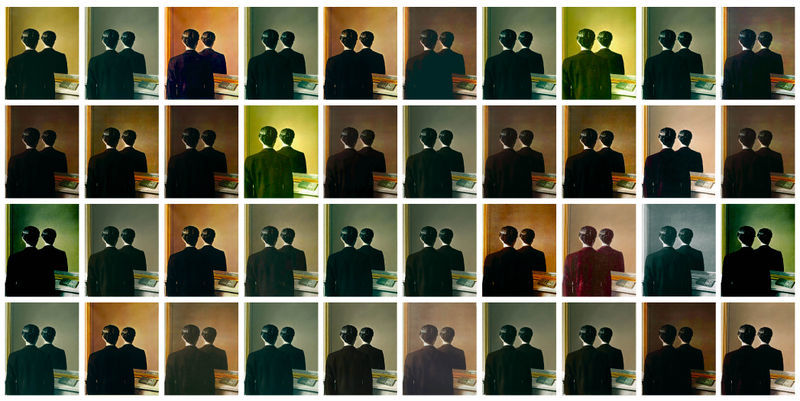
The 40 copy's with the correct process colors.
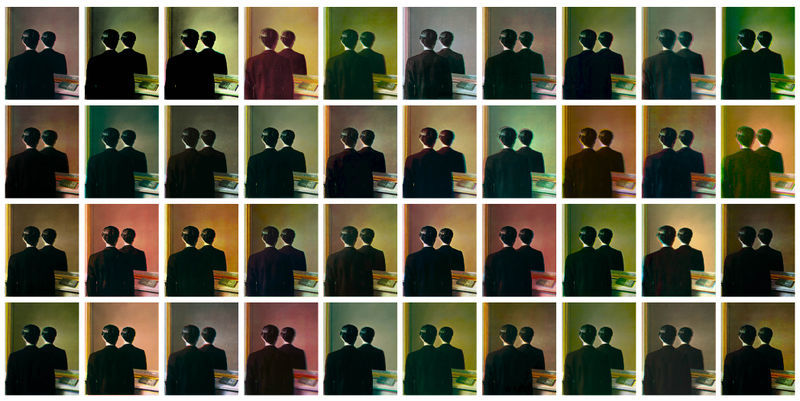
The 40 copy's with the process colors mixed
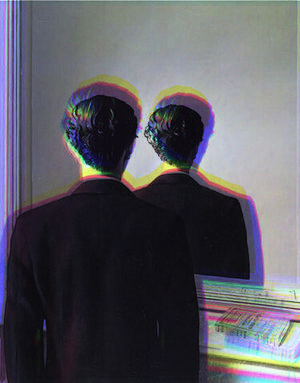
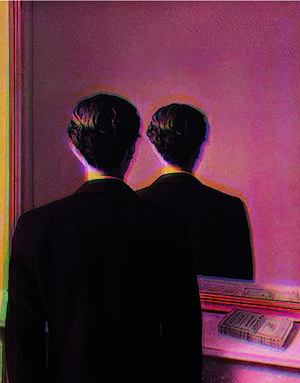
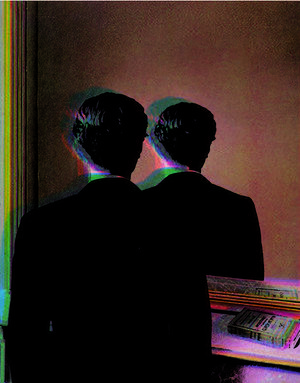
In these 3 close-ups you can see clearly the difference in all the copy's. The colors are ... and the you can see the diifrent layers clearly with the overlapping
Het verschil is goed te zien door het grote kleur verschil; voornamelijk in de achtergrond. Maar je kan ook zien dat naast de kleur, de vorm verschilt. en dat daar door de drukgang kleuren niet goed aansluiten
Transformation
research
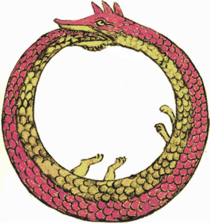
Self-reference and optical feedback
Self-reference occurs in natural or formal languages when a sentence, idea or formula refers to itself. The reference may be expressed either directly—through some intermediate sentence or formula—or by means of some encoding. In philosophy, it also refers to the ability of a subject to speak of or refer to himself, herself, or itself: to have the kind of thought expressed by the first person nominative singular pronoun, the word "I" in English.
Self-reference is studied and has applications in mathematics, philosophy, computer programming, and linguistics. Self-referential statements are sometimes paradoxical. A paradox is a statement that apparently contradicts itself and yet might be true. Most logical paradoxes are known to be invalid arguments but are still valuable in promoting critical thinking
Some paradoxes have revealed errors in definitions assumed to be rigorous, and have caused axioms of mathematics and logic to be re-examined. One example is Russell's paradox, which questions whether a "list of all lists that do not contain themselves" would include itself, and showed that attempts to found set theory on the identification of sets with properties or predicates were flawed.Others, such as Curry's paradox, are not yet resolved.
Examples outside logic include the Ship of Theseus from philosophy (questioning whether a ship repaired over time by replacing each of its wooden parts would remain the same ship). Paradoxes can also take the form of images or other media. For example, M.C. Escher featured perspective-based paradoxes in many of his drawings, with walls that are regarded as floors from other points of view, and staircases that appear to climb endlessly.
In common usage, the word "paradox" often refers to statements that are ironic or unexpected, such as "the paradox that standing is more tiring than walking".
Video feedback is the process that starts and continues when a video camera is pointed at its playback video monitor. Douglas Hofstadter discusses video feedback in his book I Am a Strange Loop about the human mind and consciousness. He devotes a chapter to describing his experiments with video feedback.
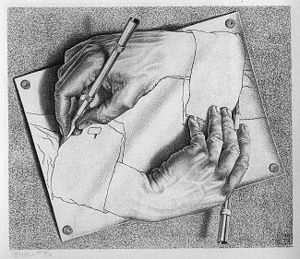
I like Hofstadter's image of a video camera looking at itself to produce a swirling video pattern where images at the periphery of the images become part of the swirling pattern, thus part of the loop (the cover illustration gives an example of this). Human consciousness, too, transforms itself to whatever input it receives. Selfhood does not exist in a vacuum as a solitary thing separate from other selves. Instead, each of us incorporates a part of other selves, each contributing a part of the periphery of input, similar to a video camera looking at itself in a mirror. Thus we humans become part of our inputs, which includes other selves. Rather than thinking of selfhood as a different kind of self from other selves, we differ only by degree (albeit, a large degree).
Source: Self reference
Source: I am a strange loop
Source: Paradox
Source:
Source:
Source:
experiments
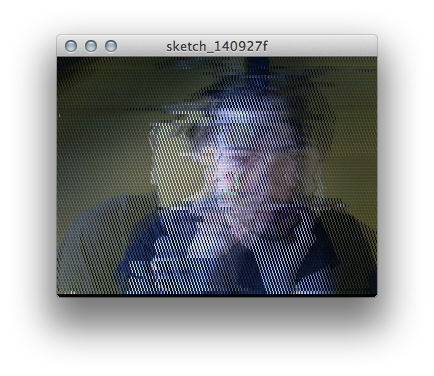
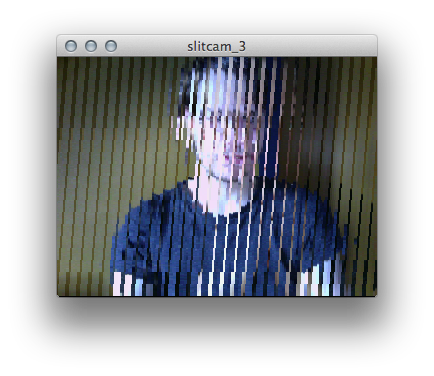
first try on the 'slit cam' What it basically does it shows a row of pixels with each pixel a different color. The pixel color is the same as te pixel color on that place on the webcam input.
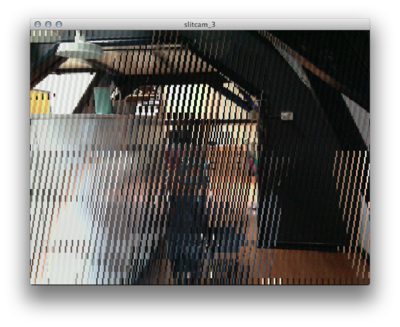
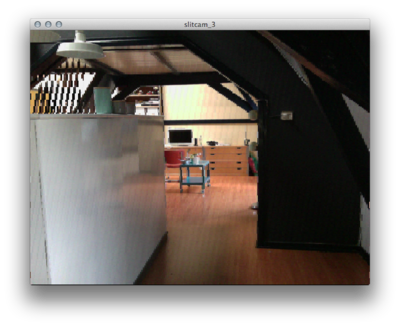
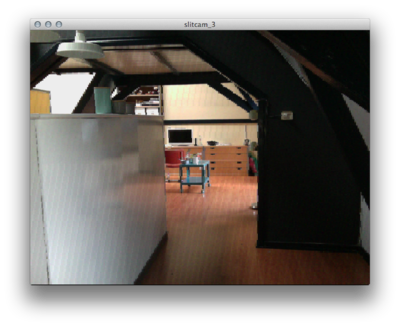
Changing the number of pixels and lines.
The first pictures shows a mix of me and my room. the second is the room and me in the kitchen. the third is just the room.
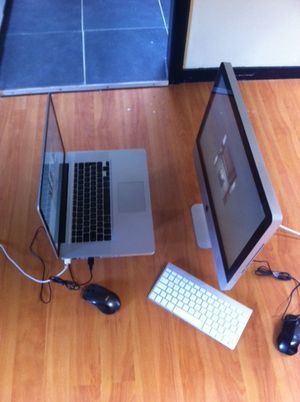
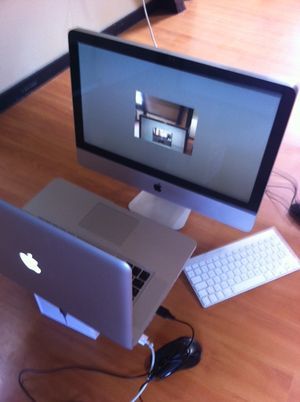
Next up is the two cameras filming each other with the same code.
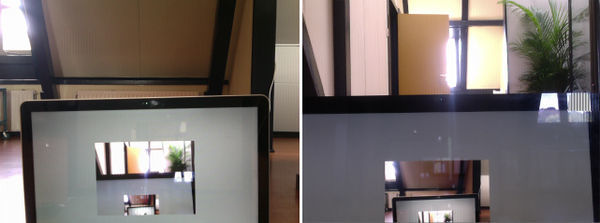
The two screen caps show the result of filming each other for 3 min.
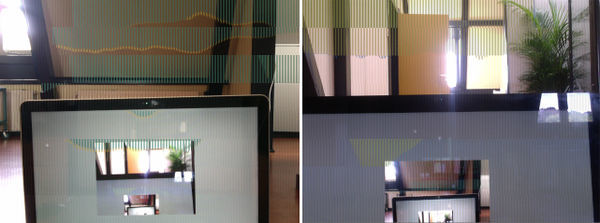
Now with a a piece of yellow and blue paper between the camera. and slowly replaced with my hand, you can see the previous capture on the other screen.
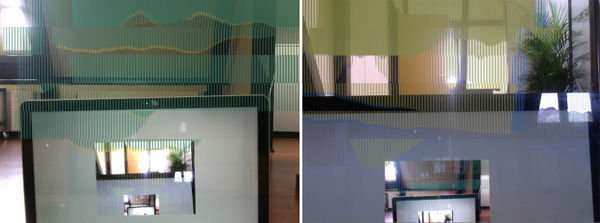
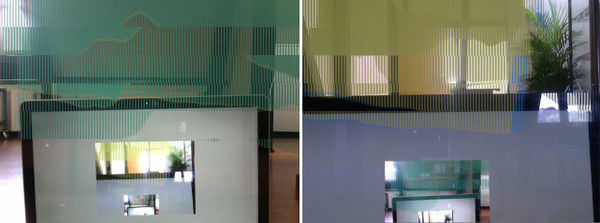
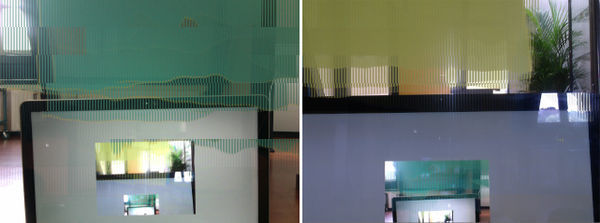
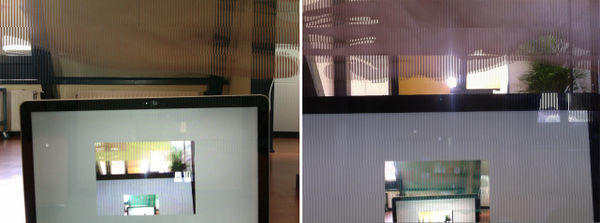
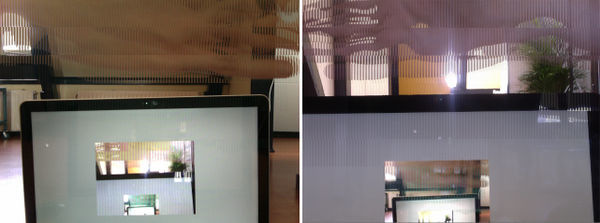
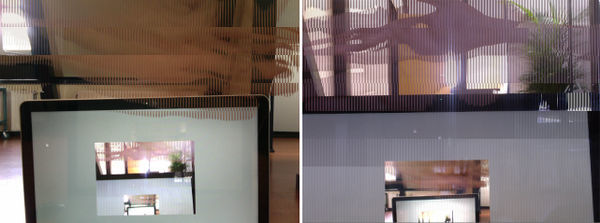
Processing
MERGE CAM:
import processing.video.*;
Capture cam;
PImage[] buffer;
int nFrames = 100;
int iWrite = 0, iRead = 1;
void setup(){
background (0);
size(640, 480);
cam = new Capture(this, width, height);
cam.start();
buffer = new PImage[nFrames];
}
void draw() {
if(cam.available()) {
cam.read();
buffer[iWrite] = cam.get();
if(buffer[iRead] != null){
image(buffer[iRead], 0, 0);
}
iWrite++;
iRead++;
if(iRead >= nFrames-1){
iRead = 0;
}
if(iWrite >= nFrames-1){
iWrite = 0;
}
image(cam, 0, 0, width, height);
tint(225, 126);
}
}
INFO.
DUO_CAM:
import processing.video.*;
Capture cam;
PImage[] buffer;
int nFrames = 200;
int iWrite = 0, iRead = 1;
void setup(){
background (0);
size(1280, 480);
cam = new Capture(this, width, height);
cam.start();
buffer = new PImage[nFrames];
}
void draw() {
if(cam.available()) {
cam.read();
buffer[iWrite] = cam.get();
if(buffer[iRead] != null){
image(buffer[iRead], 0, 0, width/2, height);
}
iWrite++;
iRead++;
if(iRead >= nFrames-1){
iRead = 0;
}
if(iWrite >= nFrames-1){
iWrite = 0;
}
image(cam, width/2, 0, width/2, height);
tint(225, 126);
}
}
INFO.
TIME&SPACE_CAM:
import processing.video.*;
Capture cam;
int i,j = 0;
void setup() {
background(0);
size(640,480);
frameRate(60); //speed
cam = new Capture(this, width, height, 60); //Capture(parent, requestWidth, requestHeight, frameRate)
cam.start();
}
void draw() {
if(cam.available()) {
cam.read();
}
color c00 = cam.get(i, j);
color c02 = cam.get(i, j + 1);
color c03 = cam.get(i, j + 2);
color c04 = cam.get(i, j + 3);
color c05 = cam.get(i, j + 4);
color c06 = cam.get(i, j + 5);
color c07 = cam.get(i, j + 6);
color c08 = cam.get(i, j + 7);
color c09 = cam.get(i, j + 8);
color c10 = cam.get(i, j + 9);
color c11 = cam.get(i, j + 10);
color c12 = cam.get(i, j + 11);
color c13 = cam.get(i, j + 12);
color c14 = cam.get(i, j + 13);
color c15 = cam.get(i, j + 14);
color c16 = cam.get(i, j + 15);
color c17 = cam.get(i, j + 16);
color c18 = cam.get(i, j + 17);
color c19 = cam.get(i, j + 18);
color c20 = cam.get(i, j + 19);
color c21 = cam.get(i, j + 20);
color c22 = cam.get(i, j + 21);
color c23 = cam.get(i, j + 22);
color c24 = cam.get(i, j + 23);
color c25 = cam.get(i, j + 24);
color c26 = cam.get(i, j + 25);
color c27 = cam.get(i, j + 26);
color c28 = cam.get(i, j + 27);
color c29 = cam.get(i, j + 28);
color c30 = cam.get(i, j + 29);
color c31 = cam.get(i, j + 30);
color c32 = cam.get(i, j + 31);
color c33 = cam.get(i, j + 32);
color c34 = cam.get(i, j + 33);
color c35 = cam.get(i, j + 34);
color c36 = cam.get(i, j + 35);
color c37 = cam.get(i, j + 36);
color c38 = cam.get(i, j + 37);
color c39 = cam.get(i, j + 38);
color c40 = cam.get(i, j + 39);
color c41 = cam.get(i, j + 40);
color c42 = cam.get(i, j + 41);
color c43 = cam.get(i, j + 42);
color c44 = cam.get(i, j + 43);
color c45 = cam.get(i, j + 44);
color c46 = cam.get(i, j + 45);
color c47 = cam.get(i, j + 46);
color c48 = cam.get(i, j + 47);
color c49 = cam.get(i, j + 48);
color c50 = cam.get(i, j + 49);
color c51 = cam.get(i, j + 50);
color c52 = cam.get(i, j + 51);
color c53 = cam.get(i, j + 52);
color c54 = cam.get(i, j + 53);
color c55 = cam.get(i, j + 54);
color c56 = cam.get(i, j + 55);
color c57 = cam.get(i, j + 56);
color c58 = cam.get(i, j + 57);
color c59 = cam.get(i, j + 58);
color c60 = cam.get(i, j + 59);
stroke(c00);
point(i,j);
stroke(c02);
point(i,j+ 1);
stroke(c03);
point(i,j+ 2);
stroke(c04);
point(i,j+ 3);
stroke(c05);
point(i,j+ 4);
stroke(c06);
point(i,j+ 5);
stroke(c07);
point(i,j+ 6);
stroke(c08);
point(i,j+ 7);
stroke(c09);
point(i,j+ 8);
stroke(c10);
point(i,j+ 9);
stroke(c11);
point(i,j+ 10);
stroke(c12);
point(i,j+ 11);
stroke(c13);
point(i,j+ 12);
stroke(c14);
point(i,j+ 13);
stroke(c15);
point(i,j+ 14);
stroke(c16);
point(i,j+ 15);
stroke(c17);
point(i,j+ 16);
stroke(c18);
point(i,j+ 17);
stroke(c19);
point(i,j+ 18);
stroke(c20);
point(i,j+ 19);
stroke(c21);
point(i,j+ 20);
stroke(c22);
point(i,j+ 21);
stroke(c23);
point(i,j+ 22);
stroke(c24);
point(i,j+ 23);
stroke(c25);
point(i,j+ 24);
stroke(c26);
point(i,j+ 25);
stroke(c27);
point(i,j+ 26);
stroke(c28);
point(i,j+ 27);
stroke(c29);
point(i,j+ 28);
stroke(c30);
point(i,j+ 29);
stroke(c31);
point(i,j+ 30);
stroke(c32);
point(i,j+ 31);
stroke(c33);
point(i,j+ 32);
stroke(c34);
point(i,j+ 33);
stroke(c35);
point(i,j+ 34);
stroke(c36);
point(i,j+ 35);
stroke(c37);
point(i,j+ 36);
stroke(c38);
point(i,j+ 37);
stroke(c39);
point(i,j+ 38);
stroke(c40);
point(i,j+ 39);
stroke(c41);
point(i,j+ 40);
stroke(c42);
point(i,j+ 41);
stroke(c43);
point(i,j+ 42);
stroke(c44);
point(i,j+ 43);
stroke(c45);
point(i,j+ 44);
stroke(c46);
point(i,j+ 45);
stroke(c47);
point(i,j+ 46);
stroke(c48);
point(i,j+ 47);
stroke(c49);
point(i,j+ 48);
stroke(c50);
point(i,j+ 49);
stroke(c51);
point(i,j+ 50);
stroke(c52);
point(i,j+ 51);
stroke(c53);
point(i,j+ 52);
stroke(c54);
point(i,j+ 53);
stroke(c55);
point(i,j+ 54);
stroke(c56);
point(i,j+ 55);
stroke(c57);
point(i,j+ 56);
stroke(c58);
point(i,j+ 57);
stroke(c59);
point(i,j+ 58);
stroke(c60);
point(i,j+ 59);
i += 3; //aantal pixels naar rechts
if (i >= width){
j += 60; //aantal pixels omlaag
i -= width;
}
if(j >= height -4 ) //wanneer terug omhoog
{
j= 0;
}
}
The code used for the optical loop experiment.
Terminal
ifconfig
Example for how to get your IP adress
openvnc://yourusername@123.456.789.0
Inserting this in the terminal will open a window with the desktop of the other computer.
/System/Library/Frameworks/ScreenSaver.framework/Resources/ScreenSaverEngine.app/Contents/MacOS/ScreenSaverEngine -background
Make a screensaver as an background.
Transformation
{{#ev:youtube|https://www.youtube.com/watch?v=FkfijvOm_sc%7C500}}
raw link
The result when two iMac screen are referring to themselves.
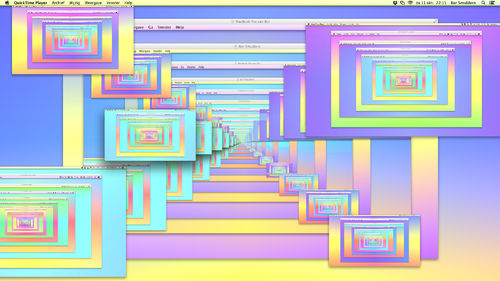
Screenshot
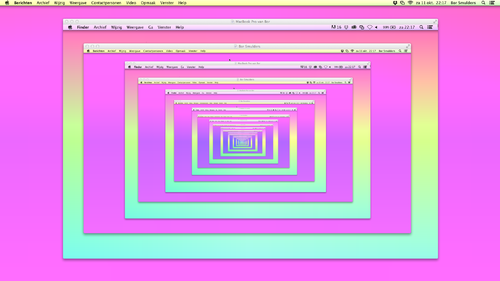
Screenshot

